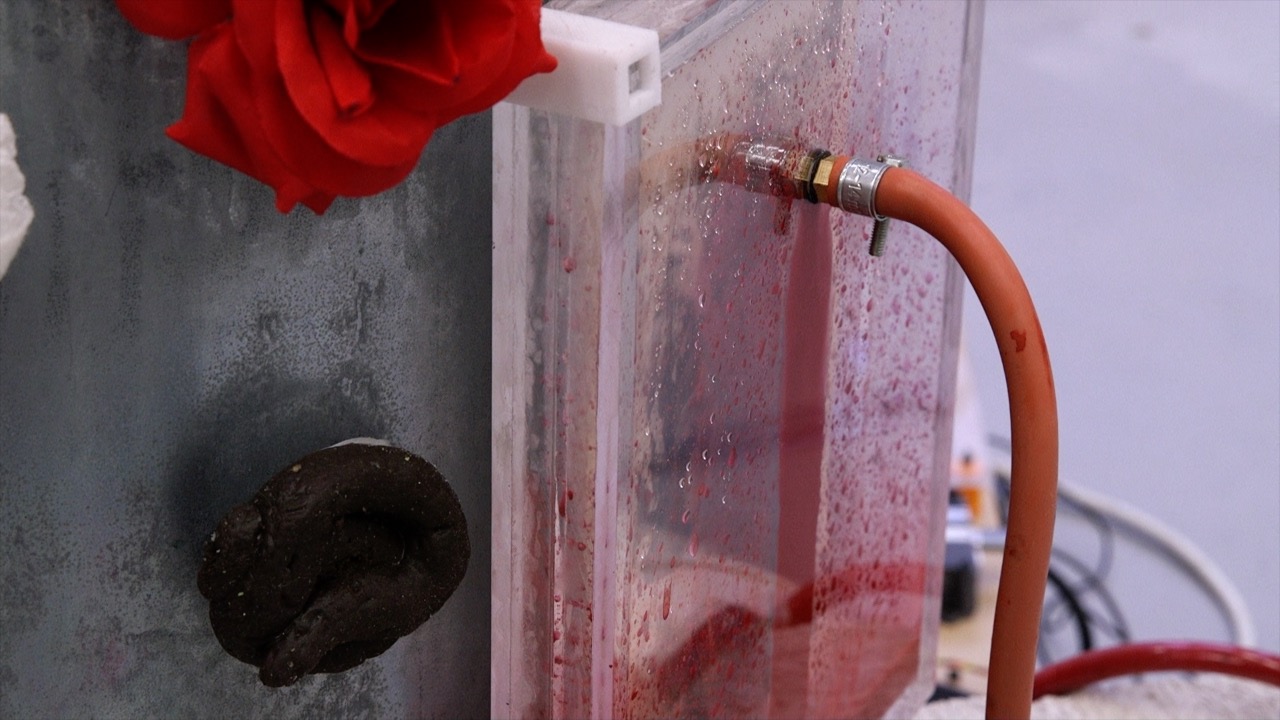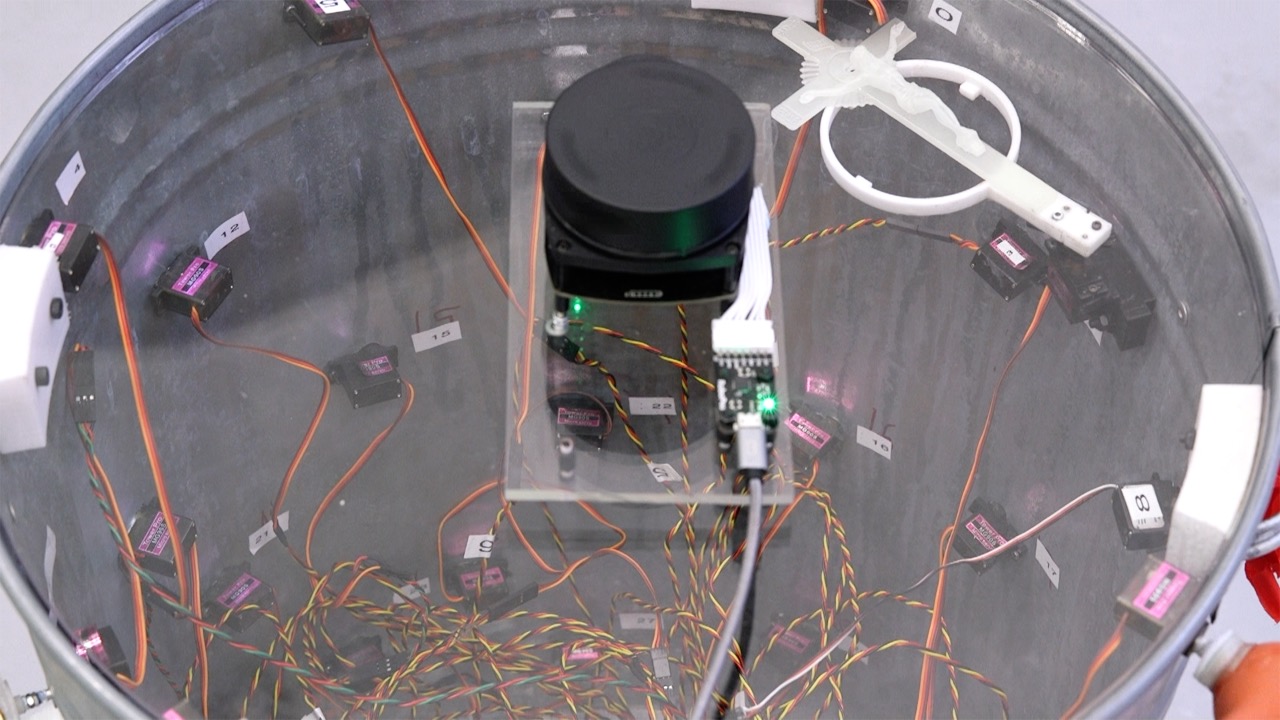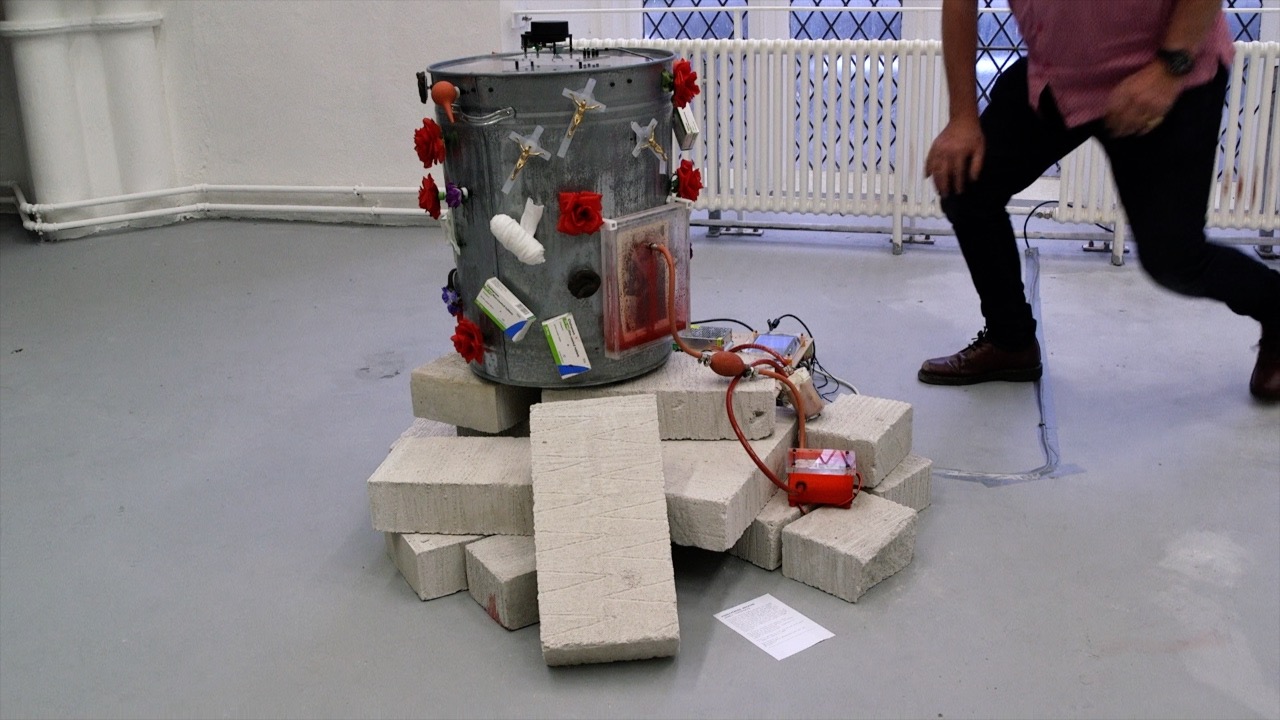Forgiveness Machine
Forgiving what? – My mother Josette and the sins she dealt me. An Installation.
produced by: James Tregaskis
Introduction
I am interested in the power of art to create a visceral reaction – if this occurs, I feel it has been successful.
Two strands pull me towards the end goal for my work.
- A main theme has emerged, to look back on my life, particularly my mother Josette. She dealt me many mental and physical blows, some too unpleasant to describe, striking deep, damage inflicted on me arising from her narcissism, sadism, sexual problems and neuroses. In my teens, I was moved by seeing Truffaut’s film, Les Quatre Cent Coups (The 400 blows, French meaning; ‘to raise hell’) - I was not alone. I raised hell.
- The technical motives for the work are harder to define. I find myself drawn to novelty; this, a weakness but also a strength. In earlier work during the course I found sonar and time of flight sensors to be limited in range. I wanted a more powerful means of tracking and found Lidar an excellent option.
The appearance of people nearby stimulates movement in the machine it washes her face with blood while she gazes at her reflection in the mirror.
My aim was to connect the viewer of the installation to my own personal life. Revealing one’s vulnerability in an honest and open way is not the typical way for men to behave in our culture. The Forgiveness Machine goes some way to expose the struggle a son experiences with a controlling and cruel mother.
My intention is to investigate the emotional component of intimate relationships and thus create affect. The use of flowers and faeces, religious iconography and antidepressants is no accident; neither is the shock of seeing blood being fired at my mother’s face.
Forgiveness Machine is dependent on the presence of other people approaching, thus generating good causes in order to forgive my mother. This is reminiscent of a prayer wheel. The ‘prayer wheel’, being ‘turned’ by people approaching the installation and transforming it into good intentions.
She expressed her counterfeit religiosity when she took me to the priests ‘by the ear’ to ask them to pray for my soul (for £5). She used this drama to impose her will and her 'love of god' . Plastic crucifixes twirl in a comedic manner.
Concept
My aim was to connect the viewer of the installation to my own personal life. Revealing one’s vulnerability in an honest and open way is not the typical way for men to behave in our culture. The Forgiveness Machine goes some way to expose my struggle.
Another aspect of my work which I am interested in is affect, and to investigate the emotional component of intimate relationships. The use of flowers and faeces, religious iconography and antidepressants is no accident; neither is the shock of seeing blood being fired at my mother’s face.
The installation includes a screen showing Vajrayogini, the supreme deity of the Tantric pantheon , accompanied by the computer generated point cloud displaying people nearby. She is the drinker of blood, the tantric representation of the female aspect of Buddha Shakyamuni.
Forgiveness Machine is dependent on the presence of other people approaching, thus generating good causes to forgive my mother. This is reminiscent of a prayer wheel. The ‘prayer wheel’, being ‘turned’ by people approaching the installation and transforming it into good intentions.
Another humiliation was when she took me to the priests ‘by the ear’ to ask them to pray for my soul (for £5). Plastic crucifixes twirl in a comedic manner. She used this drama to impose her will and her 'love of god' .
The principal objective for me was to address the challenge of communicating truthfully and accurately. As have words in our language, we can choose to communicate with each other with found objects: as a proxy - where words may lose something in translation. We can never really capture the meaning in words, symbols connect more effectively with the audience. William Burroughs saw the word as a means of control; his lifelong interest influenced by the writings of Alfred Korzybski ("The map is not the territory") - humanity is limited by our nervous system and language. How do we use symbols in art to convey affect? Ready-made objects could be like ‘words’ communicating in a common language, the sign systems we adopt in our culture.
Influences
My Father, Hugh
Gallery owner. He sent me to Cybernetic Serendipity exhibition at the ICA in 1968. He could determine the number on his train carriage if it was a prime between Gloucester Road and Hyde Park Corner on a good day. He ran a cipher unit in the middle east during the war. I am sure he would be intrigued with Computational Art as it is today.
Louise Bourgeois
French/American artist; she inspired me when I saw her retrospective in Tate London 2007 and in Hamburg several years ago. She had problems with her father and loathed him. She developed art as a means of expressing her struggles in life. Bourgeois often spoke of pain as the subject of her art, and fear: fear of the grip of the past, of the uncertainty of the future, of loss in the present.
"The subject of pain is the business I am in", she said.
Luis Buñuel
He provoked great controversy, presenting disturbing imagery through his Surrealism and critique of the Catholic church. In particular, L’Age D’Or, for a while it was banned.
The writings of William S Burroughs
His irreverence for institutions, his theme of undermining ‘control’ – Cities of the Red Night, essays in ‘The Job’
Marcel Duchamp
Pioneer of ready-made art, notably, his Urinal “Fountainhead” – found objects/Surrealism.
Andres Serrano
Serrano, a catholic, misunderstood. His intention was to show how the church had been devalued: “Piss Christ” I first saw this in a magazine in 1987, this was vandalised in a show in Avignon in 2011
Mike Kelley
found objects, Addresses: "the rising infatuation of the public with issues of repressed memory syndrome and child abuse... The implication is that anything that can't be remembered is somehow the result of trauma."
Tracy Emin
She was inspired and collaborated with Louise Bourgeois. “My Bed” installation at Tate Liverpool. Her retrospective at the Tate, London “Everyone I have slept with”. Confessional art. Found objects: (objets trouvé), also seen in Tracey Emin’s “My Bed” and many other 20th century artists e.g. Haim Steinbach.
The Dadaists
Rejecting the aestheticism of modern society, notably: Max Ernst, André Breton, KurtSchwitters, Paul Éluard, Tristan Tzara
Technical
The Lidar: I obtained a second-hand lidar (Neato XV Lidar) unit, extracted from a Neato robot vacuum cleaner to a Raspberry Pi, installed Raspbian and ROS (Robot Operating System). I visualised the data coming from the Lidar using rviz. This proving the efficacy of the unit I had bought. However, this was short-lived, and this second-hand unit failed after a few days of use.
Further research revealed a newer, better made Lidar, RPlidar A1, manufactured by Slamtec. This included a more reliable mechanism, providing 2000 readings a second, up to 6-8 metres range indoors (depending on background light) and resolution of 1% of the distance. RPlidar A1 uses 3.3V TTL via serial (UART) as the communication interface. Sampling is 2-10Hz sampling at 1-degree intervals. The RPlidar also came with A RoboPeak UART interface board to plug into the Raspberry Pi’s USB port.
My installation used 2 Raspberry Pi’s (model 3 B+) to spread the processing demand.
Raspberry Pi #1. Running Python sketch to capture Lidar and forward to Pi 2. Via Open Sound Control (OSC). The OSC messages were connected via a TripMate [1]portable router so that each Raspberry Pi could have a static IP address making setting up simpler, avoiding the college WiFi.
Raspberry Pi #2. Running Processing sketch to receive OSC messages, throttle the data (i.e. not only to reduce the overall data flow but also ignore readings beyond a desired distance value; approximately 5 metres). The same Processing sketch forwarded this throttled, validated data on to another Python program running on another port on the same Pi (No.2) – this operating the servos via the I2C pins on the Pi’s GPIO to a ‘daisy-chained’ set of 16 channel PWM boards.
However, it became apparent that the Python program that I had used a Python module (Python-OSC) that suffered a memory leak. The problem was circumvented by writing a bash script that called another Python script to create and kill the Pi #2 Python servo program every 2 seconds. This kept the CPU demand below 60%. I still found the servos eventually stopped as the Python script still became unresponsive.
The solution for the exhibition was to modify the Pi #2’s Python-servo program to run in ‘random mode’. I had several routines to choreograph the pump and servos in an interesting way. I ran the interactive version of the same program for the exam and video.
I prototyped the pump and servos using an Arduino. I calibrated the medical pump to run at a lower PWM frequency than the mini (SG90S) servos.
In order to ensure a steady power supply, given all 38 servos could potentially move at the same time, consuming peaks of current demand, I wired two 10A 5v power supplies in parallel and a separate 12v 10A power supply for the medical pump. All three were linked by a common ground. I used an H bridge with a large heatsink to drive the medical pump. (See Fritzing schematic).
During testing, I used a spreadsheet to keep track of the servos and QA them. Some servos were converted to become continuous rotation servos, I soldered small surface mount resistors inside, replacing the rheostat inside and re-assembled them.
Source code for project on GitHub at: https://github.com/jtreg/forgiveness_machine
[1] https://www.hootoo.com/hootoo-tripmate-ht-tm05-wireless-router.html
Video of prototyping and assembly:
Future development
I was ‘bitten’ by a problem in implementing OSC-Lidar; I wanted to send OSC messages from Python to Processing (and send on to Python). I could only find one library that could do this. This library component proved to have a memory leak. The alternative was to use a more reliable library, but this only could link Python to Python. A better solution needed to be found here.
I used Raspberry Pi’s to process the Lidar data, Python and Processing. I would like to try the with a more powerful machine(s) running the code and Open Frameworks, although work would be required to interface to the Lidar.
The piece could have been larger as well. I felt it was tiny in the excellent huge space I had been given to use. I chose a dustbin because it had symbolic value and was cylindrical, perfect for the 360-degree sensing. A larger assembly/structure with components suspended on it would be interesting, perhaps as an immersive experience for the visitors.
A further development could be to extend the programming to create a performance piece.
[1] https://www.hootoo.com/hootoo-tripmate-ht-tm05-wireless-router.html
Self evaluation
Overall, the project I designed was well constructed, running reliably over the exhibition. I overcame the limitations of proximity sensors with a limited range -time of flight sensors and ultrasonic sensors. I encountered some challenges in implementing the lidar device and learned a lot in that process.
I feel I could have put some more time into balancing the action-reaction or ‘friction’ as coined by Andrew Shoben. It is a delicate balance; too prescriptive and the installation is predictable and less engaging, too chaotic and the sensing/computational element is lost, and we merely have a random automaton.
I took the advice of a visiting artist from Lovid [1], arranging the interactivity into choreographed groups. I still feel I have a lot more to learn in this area and this will lead me into exploring more performative installations for example.
Anecdotally, feedback I received was positive, however, on the third day I was contacted by a person who wants to meet up to show my installation in her gallery which was a great boost for me.
[1] http://lovid.org/
References
https://simonosullivan.net/articles/aesthetics-of-affect.pdf
https://www.ev3dev.org/docs/tutorials/using-xv11-lidar/
https://wiki.ros.org/xv_11_laser_driver/Tutorials
www.getsurreal.com/products/xv-lidar-controller
http://roboticsweekends.blogspot.com/2017/12/how-to-connect-neato-xv-11-lidar-to.html
https://www.youtube.com/watch?v=4sQCz75BfrM
https://www.youtube.com/watch?v=yLPM2BVQ2Ws
https://xv11hacking.wikispaces.com/LIDAR+Sensor
https://www.youtube.com/watch?v=wVsfCnyt5jA
http://www.ros.org/
https://learn.adafruit.com/16-channel-pwm-servo-driver/using-the-adafruit-library
https://www.modmypi.com/raspberry-pi/robotics-and-motor-controllers-392/motor-controller-boards-1019/adafruit-pwmservo-driver-16-channel-12-bit-pca9685
https://www.electronicshub.org/raspberry-pi-l298n-interface-tutorial-control-dc-motor-l298n-raspberry-pi/
Louise Bourgeois: https://www.theglobeandmail.com/news/world/sculptor-louise-bourgeois-mined-a-vein-of-pain-and-suffering/article1371894/
Haim Steinbach: http://www.haimsteinbach.net/



































































